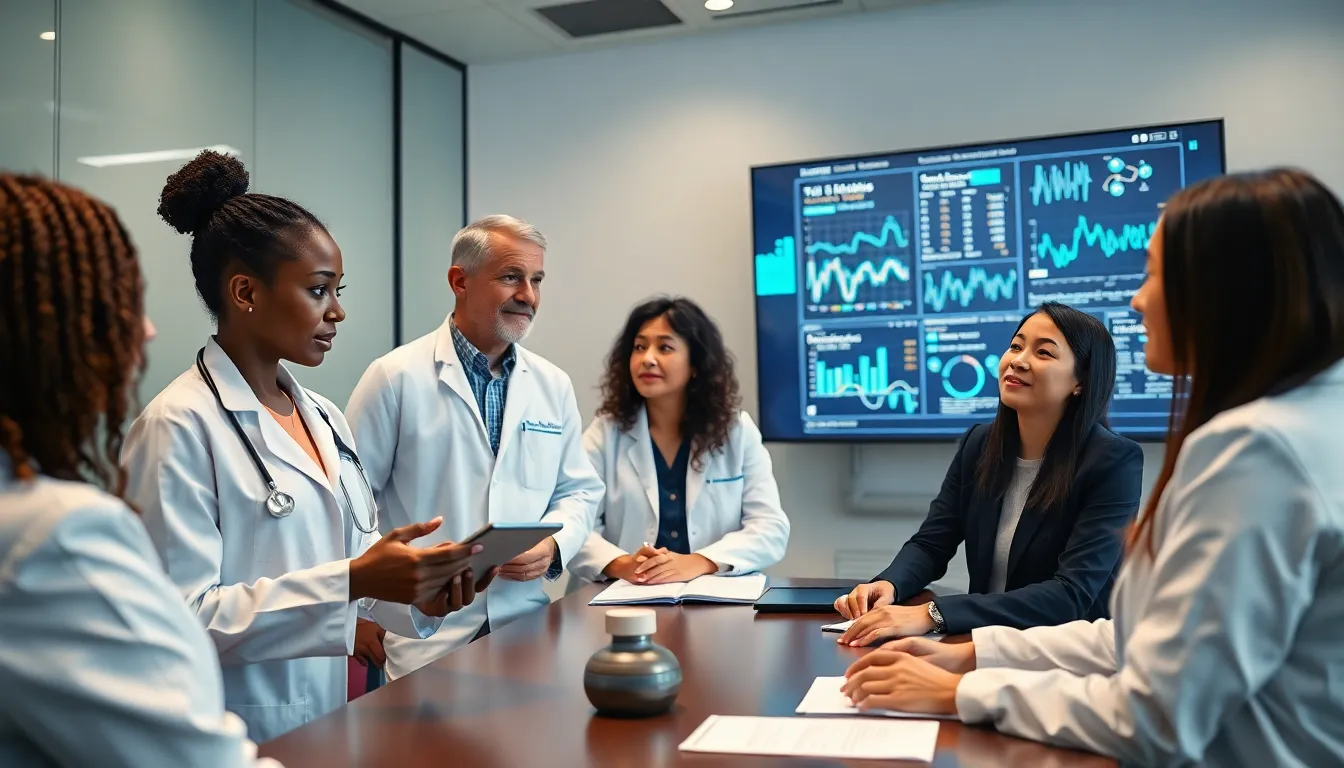Table of Contents
ToggleIn a world where medical breakthroughs happen faster than a cat video goes viral, global medical affairs stands at the forefront, bridging the gap between science and the everyday patient. It’s not just a fancy title; it’s the superhero of the healthcare realm, ensuring that life-saving information reaches those who need it most.
Overview of Global Medical Affairs
Global medical affairs plays a vital role in healthcare, linking scientific research to patient care. This field enhances the understanding of medical products and their therapeutic benefits.
Definition and Scope
Global medical affairs encompasses a wide range of activities aimed at ensuring access to accurate scientific information. Its scope includes managing relationships with healthcare professionals and stakeholders, conducting medical education, and overseeing clinical research data. Furthermore, it involves collaborating with regulatory authorities to facilitate the appropriate use of medical products globally. The field addresses gaps between research findings and clinical practice through comprehensive strategies and communication.
Importance in the Pharmaceutical Industry
In the pharmaceutical industry, global medical affairs serves as a bridge between innovation and patient access. This function supports drug development by providing insights into market needs and healthcare trends. Medical affairs teams educate healthcare professionals about product efficacy and safety, enhancing treatment protocols. Effective communication strategies improve understanding of scientific data, driving informed decision-making. This aspect strengthens the credibility of pharmaceutical companies, fostering trust among stakeholders and patients.
Key Functions of Global Medical Affairs

Global medical affairs encompasses various critical functions that enhance healthcare delivery and innovation. These functions focus on connecting scientific knowledge with clinical practice and patient needs.
Medical Communications
Medical communications serve as a vital link between clinical data and healthcare professionals. Teams create and disseminate materials that summarize findings from clinical studies. They ensure that accurate, evidence-based information reaches practitioners and patients alike. Engagement through various channels, such as scientific publications and presentations, fosters collaboration and increases understanding of new therapies. By maintaining transparency around product information, medical communications build credibility and trust in the healthcare community.
Clinical Trial Support
Clinical trial support functions play a central role in the successful execution of research initiatives. Medical affairs teams assist in designing clinical protocols that align with regulatory requirements and market needs. Collaboration with investigators and healthcare professionals ensures trials meet scientific rigor, which drives patient recruitment and retention. Access to up-to-date training and resources during trials enhances investigator performance. Collectively, these efforts contribute to timely study completion and effective data analysis, ultimately shaping treatment advancements.
Regulatory Affairs
Regulatory affairs guide companies through complex authorization processes for new therapies. Medical affairs teams collaborate closely with regulatory bodies to navigate compliance requirements and clinical data submissions. They strategize on submissions to ensure efficient approvals while adhering to local and international guidelines. By engaging in dialogue with regulatory authorities, these teams facilitate a comprehensive understanding of the evolving landscape of drug regulations. Their involvement ensures expedited access to medicines for patients while upholding safety and efficacy standards.
Trends in Global Medical Affairs
Global medical affairs adapts to emerging trends that shape healthcare delivery and innovation. Two key trends are digital transformation and patient-centric approaches.
Digital Transformation
Digital transformation revolutionizes how global medical affairs operates. Virtual platforms enhance real-time communication with healthcare professionals. Technologies like artificial intelligence analyze vast datasets, providing insights into market needs. Telemedicine expands access to medical expertise, allowing patients and providers to connect remotely. Utilizing digital channels for medical education delivers timely information to healthcare practitioners, ensuring they stay informed about the latest developments in treatments and clinical guidelines. Automation streamlines administrative tasks, allowing teams to focus more on strategic initiatives. Overall, digital tools improve engagement and ultimately drive more effective medical affairs strategies.
Patient-Centric Approaches
Patient-centric approaches prioritize the needs and experiences of patients in global medical affairs. Insights from patient feedback shape product development, ensuring therapies address real-world challenges. Educational initiatives tailored to patients enhance understanding of treatment options and their benefits. Collaboration between medical affairs teams and patient advocacy groups strengthens relationships and aligns goals. Empowering patients through shared decision-making nurtures trust and adherence to treatment plans. Focused efforts to address health disparities lead to more equitable access to innovative therapies. By centering on patients, global medical affairs improves healthcare outcomes and fosters greater satisfaction among patients and providers alike.
Challenges Faced by Global Medical Affairs
Global medical affairs encounters several significant challenges impacting its functions. Understanding these obstacles helps clarify the field’s complexities.
Regulatory Compliance
Regulatory compliance poses a critical challenge for global medical affairs. Ensuring adherence to diverse regulations across multiple countries requires extensive knowledge and agility. Different markets impose unique requirements, complicating the approval processes for new treatments. Companies often struggle to align their strategies with regional regulations, which can lead to delays. Continuous updates to policies necessitate constant vigilance and adaptation. Moreover, failure to meet compliance standards can result in severe penalties, affecting product marketability. As a result, global medical affairs teams must prioritize understanding and integrating federal and international regulations efficiently.
Resource Allocation
Resource allocation represents another major challenge in global medical affairs. Allocating resources effectively requires careful planning and strategic foresight. Limited budgets can restrict access to skilled personnel and advanced technologies. Teams often face pressure to maximize impact while managing constrained resources across various initiatives. As projects like clinical trial support or medical education campaigns demand significant investments, competing demands can lead to difficult prioritization decisions. Balancing immediate needs with long-term goals becomes crucial. Global medical affairs teams must develop flexible approaches to optimize resource distribution while maintaining high-quality standards.
Future Directions in Global Medical Affairs
Global medical affairs is evolving rapidly, driven by technological advancements and the need for a skilled workforce. These changes shape the future landscape of this vital field.
Emerging Technologies
Emerging technologies increasingly transform global medical affairs. Innovations like artificial intelligence enhance data analysis, providing deeper insights into market trends and patient needs. Virtual platforms enable real-time interactions among stakeholders, streamlining communication and decision-making processes. Telemedicine expands access to specialists, improving patient outcomes across various demographics. Notably, blockchain technology ensures transparency in clinical data sharing, strengthening trust between pharmaceutical companies and healthcare professionals. Each of these technologies plays a significant role in revolutionizing how medical affairs teams operate, ensuring they remain agile and responsive to industry changes.
Workforce Development
Workforce development focuses on building a robust team within global medical affairs. Continuous education and training foster a culture of learning and adaptation in this fast-paced environment. Specialized programs equip professionals with the skills needed for emerging technologies, enhancing their ability to manage complex data and navigate regulatory landscapes. Collaboration with educational institutions creates pathways for new talent, ensuring a steady influx of skilled individuals into the field. Additionally, mentoring programs support career growth and retention, strengthening organizational knowledge and expertise. Effective workforce development strategies contribute to a more prepared and capable team ready to meet future challenges in global medical affairs.
Global medical affairs is pivotal in bridging the gap between scientific innovation and patient access. Its multifaceted approach ensures that accurate information reaches healthcare professionals and patients alike. By adapting to emerging trends and technologies, this field is positioned to enhance healthcare delivery and improve patient outcomes.
As challenges arise in regulatory compliance and resource management, the focus on strategic initiatives becomes essential. Investing in workforce development and leveraging digital tools will empower teams to navigate the complexities of the industry. Ultimately, the ongoing evolution of global medical affairs promises to foster trust and collaboration, driving advancements that benefit both healthcare providers and patients.




